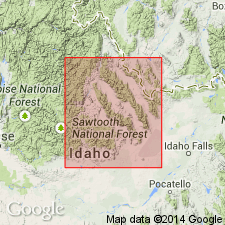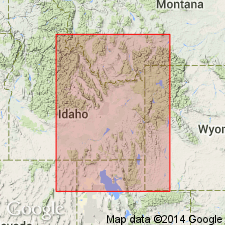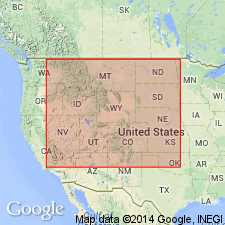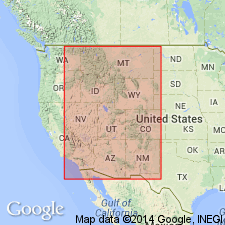
- Usage in publication:
-
- McGowan Creek Formation*
- Modifications:
-
- Named
- Biostratigraphic dating
- Dominant lithology:
-
- Argillite
- Siltstone
- AAPG geologic province:
-
- Idaho Mountains province
Summary:
Named for exposures on ridge south of McGowan Creek in N1/2 sec 28 and E1/2 sec 29, T12N, R21E, Doublespring 15-minute quad, Custer Co, ID in the Idaho Mountains province. These exposures designated the type section. Divisible into: 1) a lower member 3,175 ft thick composed of grayish-black, carbonaceous, noncalcareous to slightly calcareous, thin-bedded argillite, silty argillite, and siltite with interbeds of medium-gray, very fine to fine-grained, partly gritty to conglomeratic sandstone and quartzite and dark-gray, silty, micritic limestone, and 2) an upper member 470 ft (143 m) thick composed of dark-gray and pale-yellowish-brown, thin-bedded, calcareous siltstone interbedded with dark-gray, silty, micritic limestone. Unconformably underlain by Trident Member of Three Forks Formation. Gradationally overlain by Middle Canyon Formation. Was called Milligen Formation in earlier reports (Ross, 1934). Is a flysch unit deposited on the east side of the Antler foreland basin. Correlates with lower part of Copper Basin Formation. Grades into Lodgepole Limestone and into lower part of Mission Canyon Limestone. Dated as middle Kinderhookian at base and early Osagean at top (conodonts), or as Early Mississippian.
Source: GNU records (USGS DDS-6; Denver GNULEX).

- Usage in publication:
-
- McGowan Creek Formation*
- Modifications:
-
- Age modified
- Biostratigraphic dating
- AAPG geologic province:
-
- Idaho Mountains province
Summary:
Age of the McGowan Creek Formation is revised from Early Mississippian (Kinderhookian and Osagean) to: Early and Late Mississippian (Kinderhookian, Osagean, Meramecian) based on fossils [conodonts, foraminifers].
Source: GNU records (USGS DDS-6; Menlo GNULEX).

- Usage in publication:
-
- McGowan Creek Formation*
- Modifications:
-
- Biostratigraphic dating
- AAPG geologic province:
-
- Snake River basin
Summary:
Is entirely of Kinderhookian and early Osagean, or Early Mississippian age in Long Canyon, ID on the west side of the Beaverhead Mountains, Clark Co in the Snake River basin. The conodont zone SIPHONODELLA ISOSTICHA recognized at base of formation. In Longs Canyon, the formation unconformably overlies Sappington Member of Three Forks Formation; underlies Middle Canyon Formation; is 90+/-m thick.
Source: GNU records (USGS DDS-6; Denver GNULEX).

- Usage in publication:
-
- McGowan Creek Formation*
- Modifications:
-
- Areal extent
- Overview
- AAPG geologic province:
-
- Idaho Mountains province
- Snake River basin
Summary:
Extended into Beaverhead Mountains, Lemhi Range, southern Lost River Range, and White Knob Mountains, within Lemhi, Clark, Butte, and Custer Cos, ID, Idaho Mountains province and Snake River basin. [In White Knob Mountains, Milligen and Copper Basin Formations as mapped by Nelson and Ross, (1969) are replaced in this report by McGowan Creek.] Cross sections; isopach maps. Correlation chart shows McGowan Creek correlates with lower part of Copper Basin Formation in Pioneer Mountains. Thickness ranges from 1,220 m thick in White Knob Mountains to 30 m in Beaverhead Mountains. Divided into lower and upper members. Upper member, which ranges in thickness from 60-150 m, occurs only north and west of Hawley Mountain where McGowan Creek is thickest. Unconformably overlies Carey Dolomite in White Knob Mountains and Three Forks Formation elsewhere; conformably underlies White Knob Limestone in White Knob Mountains and Middle Canyon Formation elsewhere. Early Mississippian age.
Source: GNU records (USGS DDS-6; Denver GNULEX).

- Usage in publication:
-
- McGowan Creek Formation*
- Modifications:
-
- Biostratigraphic dating
- AAPG geologic province:
-
- Snake River basin
Summary:
Ammonoid PERICYCLUS (GONIOCYCLUS) DECIPIENS n. sp. and associated megafossils indicate Early Mississippian age. Conodonts are Kinderhookian age. Fossils collected from black slaty shale at several localities in Pioneer Mountains, Blaine Co, ID in the Snake River basin.
Source: GNU records (USGS DDS-6; Denver GNULEX).
For more information, please contact Nancy Stamm, Geologic Names Committee Secretary.
Asterisk (*) indicates published by U.S. Geological Survey authors.
"No current usage" (†) implies that a name has been abandoned or has fallen into disuse. Former usage and, if known, replacement name given in parentheses ( ).
Slash (/) indicates name conflicts with nomenclatural guidelines (CSN, 1933; ACSN, 1961, 1970; NACSN, 1983, 2005, 2021). May be explained within brackets ([ ]).

